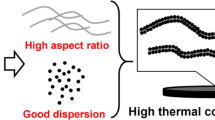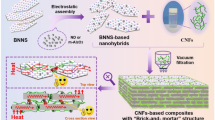Abstract
To develop a highly thermally conductive composite film, two types of ceramic fillers with different shapes were bound with cellulose nanofiber (CNF) composite fibrils densely covered with nanodiamond (ND) particles. A hexagonal boron nitride (h-BN) filler with a plate-like structure was oriented in the in-plane direction of the CNF/ND nanosheets, increasing the in-plane thermal conductivity of the h-BN-based composite film by 38.7% from 4.45 to 6.17 W/m K compared with the raw CNF/ND composite film. Conversely, the Al2O3 particles inflected the CNF/ND nanosheets and lowered the orientation of the nanosheets. The in-plane thermal conductivity of the Al2O3-based composite film was lower than that of the CNF/ND film. To develop a highly thermally conductive CNF/ND/ceramic composite film, the ceramic filler should be oriented in the plane direction, and h-BN with a high thermal conductivity is a suitable filler.
Graphical abstract






Similar content being viewed by others
References
Barnard AS, Sternberg M (2007) Crystallinity and surface electrostatics of diamond nanocrystals. J Mater Chem 17:4811–4819
Chen J, Huang X, Zhu Y, Jiang P (2017) Cellulose nanofiber supported 3D interconnected BN nanosheets for epoxy nanocomposites with ultrahigh thermal management capability. Adv Funct Mater 27:1604754
Ishizaki T, Nagano H (2015) Measurement of three-dimensional anisotropic thermal diffusivities for carbon fiber-reinforced plastics using lock-in thermography. Int J Thermophys 36:2577–2589. https://doi.org/10.1007/s10765-014-1755-5
Jakob H, Fengel D, Tschegg S, Fratzl P (1995) The elementary cellulose fibril in Picea abies: comparison of transmission electron microscopy, small-angle X-ray scattering, and wide-angle X-ray scattering results. Macromolecules 28:8782–8787
Jo I, Pettes MT, Kim J, Watanabe K, Taniguchi T, Yao Z, Shi L (2013) Thermal conductivity and phonon transport in suspended few-layer hexagonal boron nitride. Nano Lett 13:550–554
Kim K, Kim J (2016) Core-shell structured BN/PPS composite film for high thermal conductivity with low filler concentration. Compos Sci Technol 134:209–216
Lagerwall JP, Schütz C, Salajkova M, Noh J, Park JH, Scalia G, Bergström L (2014) Cellulose nanocrystal-based materials: from liquid crystal self-assembly and glass formation to multifunctional thin films. NPG Asia Materials 6:e80
Lee E-S, Lee S-M, Shanefield DJ, Cannon WR (2008) Enhanced thermal conductivity of polymer matrix composite via high solids loading of aluminum nitride in epoxy resin. J Am Ceram Soc 91:1169–1174. https://doi.org/10.1111/j.1551-2916.2008.02247.x
Morishita T, Okamoto H (2016) Facile exfoliation and noncovalent superacid functionalization of boron nitride nanosheets and their use for highly thermally conductive and electrically insulating polymer nanocomposites. ACS Appl Mater Interfaces 8:27064–27073. https://doi.org/10.1021/acsami.6b08404
Nishino T, Takano K, Nakamae K (1995) Elastic modulus of the crystalline regions of cellulose polymorphs. J Polym Sci Part B Polym Phys 33:1647–1651
Sato K, Tominaga Y, Hotta Y, Shibuya H, Sugie M, Saruyama T (2010) Thermally conductive composite films of hexagonal boron nitride and polyimide with affinity-enhanced interfaces. J Mater Chem 20:2749–2752. https://doi.org/10.1039/b924997d
Sato K, Ijuin A, Hotta Y (2015) Thermal conductivity enhancement of alumina/polyamide composites via interfacial modification. Ceram Int 41:10314–10318
Saxena IM, Brown RM Jr (2005) Cellulose biosynthesis: current views and evolving concepts. Ann Bot 96:9–21
Sichel E, Miller R, Abrahams M, Buiocchi C (1976) Heat capacity and thermal conductivity of hexagonal pyrolytic boron nitride. Phys Rev B 13:4607
Simpson A, Stuckes A (1971) The thermal conductivity of highly oriented pyrolytic boron nitride. J Phys C Solid State Phys 4:1710
Siró I, Plackett D (2010) Microfibrillated cellulose and new nanocomposite materials: a review. Cellulose 17:459–494
Song WL, Wang P, Cao L, Anderson A, Meziani MJ, Farr AJ, Sun YP (2012) Polymer/boron nitride nanocomposite materials for superior thermal transport performance. Angew Chem 124:6604–6607
Tanimoto M, Yamagata T, Miyata K, Ando S (2013) Anisotropic thermal diffusivity of hexagonal boron nitride-filled polyimide films: effects of filler particle size, aggregation, orientation, and polymer chain rigidity. ACS Appl Mater Interfaces 5:4374–4382
Tominaga Y, Sato K, Hotta Y, Shibuya H, Sugie M, Saruyama T (2018) Improvement of thermal conductivity of composite film composed of cellulose nanofiber and nanodiamond by optimizing process parameters. Cellulose 25:3973–3983
Tritt TM (2005) Thermal conductivity: theory, properties, and applications. Springer, Berlin
Uetani K, Okada T, Oyama HT (2015) Crystallite size effect on thermal conductive properties of nonwoven nanocellulose sheets. Biomacromol 16:2220–2227
Yano H, Sugiyama J, Nakagaito AN, Nogi M, Matsuura T, Hikita M, Handa K (2005) Optically transparent composites reinforced with networks of bacterial nanofibers. Adv Mater 17:153–155
Zhi C, Bando Y, Wang WL, Tang CC, Kuwahara H, Golberg D (2008) Mechanical and thermal properties of polymethyl methacrylate-BN nanotube composites. J Nanomater 2008:642036
Zhu H et al (2014) Highly thermally conductive papers with percolative layered boron nitride nanosheets. ACS Nano 8:3606–3613
Author information
Authors and Affiliations
Corresponding author
Additional information
Publisher's Note
Springer Nature remains neutral with regard to jurisdictional claims in published maps and institutional affiliations.
Rights and permissions
About this article
Cite this article
Tominaga, Y., Sato, K., Hotta, Y. et al. Effect of the addition of Al2O3 and h-BN fillers on the thermal conductivity of a cellulose nanofiber/nanodiamond composite film. Cellulose 26, 5281–5289 (2019). https://doi.org/10.1007/s10570-019-02488-9
Received:
Accepted:
Published:
Issue Date:
DOI: https://doi.org/10.1007/s10570-019-02488-9




